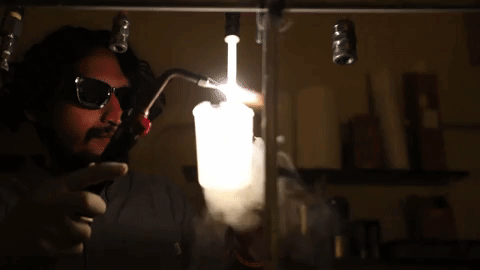Immortal switches, quantum computers could stem from new semiconductor
Material’s polarity, conductivity change with temperature.
Material’s polarity, conductivity change with temperature.

Switches that never wear out and quantum computers are two possible applications for a newly developed semiconductor whose conductive and magnetic properties change with its temperature.
The result of an accidental discovery, the material’s electrons and holes—the subatomic building blocks of conductivity and magnetism—rearrange themselves as its temperature changes. This can create a separation of electrical charges across the material (polarity), which stops electrical current from flowing.
In contrast to existing solid-state switches, which undergo shifts in atomic structure, the atoms in this material remain in place. The development is detailed in a paper published recently in the Journal of the American Chemical Society (JACS).
“As a chemist, I didn’t see this coming,” said Pierre F.P. Poudeu, an associate professor of materials science and engineering at the University of Michigan and senior author on the paper. “People have seen this in other materials but they didn’t know why it happened. We’re the first to create a chemical pathway to this property and use it to our advantage.”
People have seen this in other materials but they didn’t know why it happened. We’re the first to create a chemical pathway to this property and use it to our advantage.
Pierre F.P. Poudeu
At room temperature, the material’s electrons and holes are evenly distributed throughout the material. But when part of the material is cooled below a critical temperature, its holes migrate to the hot side of the material while its electrons migrate to the cold side. This causes the cold side to take on a negative charge while the hot side takes on a positive charge. The separation of electrons and holes also prevents it from conducting electricity. The electrons and holes migrate back to a uniform distribution as the temperature evens out, and the transition can take place an unlimited number of times.
While the property has been theoretically predicted for years and has been observed a few times in the past, the new research marks the first time researchers have mapped out why it occurs and how to control it. The material, which is a mix of iron, tin, antimony and selenium, can be tailored so that the changes occur at a specified temperature, and can be triggered with a temperature change of as little as a fraction of a degree.
“The big excitement is our understanding of how this property works and how to induce it,” Poudeu said. “We should be able to build it into any semiconductor including silicon and gallium arsenide, which opens the door to quantum devices that use changes in temperature and/or magnetic charge to store information.”
Juan Lopez, a PhD student in materials science and engineering and an author on the paper, believes the material could also be useful in electronics and switching. It could one day lead to a switch with no moving parts that shuts itself off at a given temperature, or a processor that uses minute temperature shifts to store information.
“Today, even solid-state switches and transistors rely on phase change, so they eventually fail,” said Lopez, referring to changes in atomic structure—such as transitioning between amorphous and crystalline states. “This technology could be used to build a switch with only one component—it would be much simpler to manufacture and could last essentially forever.”
Poudeu and Lopez made the discovery while experimenting with an earlier ferroelectric material made from a mix of iron, antimony and selenium. They substituted tin atoms for the antimony in hopes of increasing the material’s conductivity. It didn’t work—but it led to something far more interesting.
“Adding in the tin caused a charge imbalance, which is something we hadn’t foreseen,” Poudeu said. “Nature always finds a way to correct charge imbalances, and in this case it did that by oxidizing some of the antimony, resulting in a material with these unexpected properties.”
Poudeu cautions that application of the discovery is likely several years off—for now, the team is focused on honing their understanding of the phenomenon, generalizing it to other compounds and finding the best ways to tweak its variables to fit specific applications. The team has applied for patent protection through the U-M Office of Technology Transfer.
The paper is titled “Charge Disproportionation Triggers Bipolar Doping in FeSb2−xSnxSe4 Ferromagnetic Semiconductors, Enabling a Temperature-Induced Lifshitz Transition.” The research was supported by the National Science Foundation under award number DMR-1561008 and by the Department of Energy, Office of Basic Energy Science under award number DE-SC-0018941.